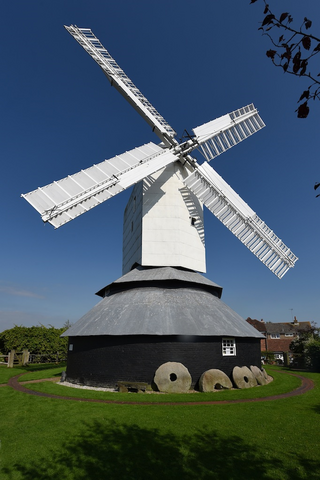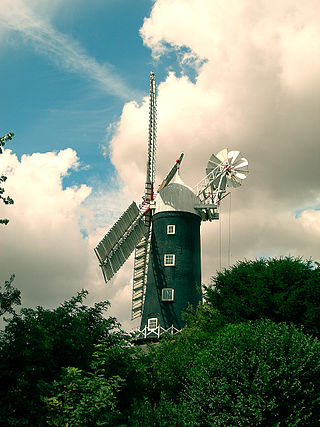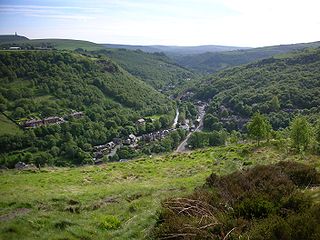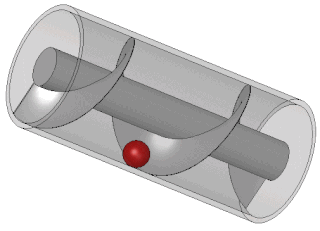
Howsham Mill is a Grade II listed [1] 18th century watermill located on the River Derwent in North Yorkshire, England.

Howsham Mill is a Grade II listed [1] 18th century watermill located on the River Derwent in North Yorkshire, England.
Howsham Mill dates back to c. 1755 and is attributed to John Carr of York. [2] It was built in the Gothic Revival style both as a working grist mill to grind grains into flour and as an eyecatcher or folly within the formal parkscape of nearby Howsham Hall.
The mill was powered by a breastshot waterwheel connected by a gear wheel to millstones that grind the grain into flour.
Milling of flour ceased in 1947 and the building fell into decay by the 1960s. [3]

In 2004 the Renewable Heritage Trust was formed by local residents with the intention of preserving and restoring the mill. [4]
Fund raising, volunteer labour and grant funding, totalling £450,000 has enabled the installation of a new waterwheel and a screw turbine based on the Archimedean screw principle to generate electricity and help fund the project in the long term. [5]
The first phase of the restoration was completed in 2007 and involved installing the new waterwheel and Archimedean screw as well as rebuilding the walls and roof of the granary to the north of the main building, allowing the installation of a kitchen and toilets as well as housing the control equipment for the hydro generation. [6]

The Mill was connected to the National Grid in 2010, allowing electricity generated to be sold. Restoration of the main part of the building was completed in 2013 providing facilities as an environmental study/community centre. A second, larger screw was commissioned in 2018 to provide additional hydro-electric generating capacity. [7]
In 2006 Howsham Mill was featured on the BBC television programme Restoration Village presented by Griff Rhys Jones. [8] It won the North regional heat and was featured in the live National Final on Sunday 17 September 2006. Although Howsham Mill did not win, a £50,000 Project Planning grant was won by reaching the final. [9]

Hydropower, also known as water power, is the use of falling or fast-running water to produce electricity or to power machines. This is achieved by converting the gravitational potential or kinetic energy of a water source to produce power. Hydropower is a method of sustainable energy production. Hydropower is now used principally for hydroelectric power generation, and is also applied as one half of an energy storage system known as pumped-storage hydroelectricity. Hydropower is an attractive alternative to fossil fuels as it does not directly produce carbon dioxide or other atmospheric pollutants and it provides a relatively consistent source of power. Nonetheless, it has economic, sociological, and environmental downsides and requires a sufficiently energetic source of water, such as a river or elevated lake. International institutions such as the World Bank view hydropower as a low-carbon means for economic development.

Whalley is a large village and civil parish in the Ribble Valley on the banks of the River Calder in Lancashire, England. It is overlooked by Whalley Nab, a large wooded hill over the river from the village. The population of the civil parish was 2,645 at the census of 2001, and increased to 3,629 at the census of 2011.

The River Rivelin is a river in Sheffield, South Yorkshire, England.

The Weald and Downland Living Museum is an open-air museum in Singleton, West Sussex. The museum is a registered charity.

Dunster Working Watermill is a restored 18th century watermill, situated on the River Avill, close to Gallox Bridge, in the grounds of Dunster Castle in Dunster, Somerset, England. It is a Grade II* listed building and within the Grade II* registered parkland of the castle.

The production of renewable energy in Scotland is a topic that came to the fore in technical, economic, and political terms during the opening years of the 21st century. The natural resource base for renewable energy is high by European, and even global standards, with the most important potential sources being wind, wave, and tide. Renewables generate almost all of Scotland's electricity, mostly from the country's wind power.

Moulton Windmill in the Lincolnshire village of Moulton, between Spalding and Holbeach is a restored windmill claimed to be the tallest tower mill in the United Kingdom.

Renewable energy in the United Kingdom contributes to production for electricity, heat, and transport.

Windmill Hill Mill is a grade II* listed post mill at Herstmonceux, Sussex, England which has been restored and now operates as a working mill. The mill is open to the public on most Sundays from Easter until October.

Skidby Windmill is a Grade II* listed windmill at Skidby near Beverley, in the East Riding of Yorkshire, England.

Sir Richard Arkwright's Masson Mill is a water-powered cotton spinning mill situated on the west bank of the River Derwent in Matlock Bath, Derbyshire in England. This mill was built in 1783. It forms part of the Derwent Valley Mills, a World Heritage Site. Nearby is Willersley Castle, the house Richard Arkwright built for himself within the parish of Matlock.

Torrs Hydro is a micro hydroelectric scheme, owned by the community, in New Mills, Derbyshire. It is located on the River Goyt, immediately after its confluence with the River Sett at the Torr weir. A 2.4-metre diameter steel trough screw turbine generates up to 63 kW of electricity.

Settle Hydro is a micro hydroelectric scheme, owned by the community, in Settle, North Yorkshire, England. It is located on the River Ribble, at Settle Weir near Bridge End Mill. It generates 50 kW of electricity using a screw turbine in part of the former mill race.

The River Calder is a river in West Yorkshire, in Northern England.

Gayle Mill, dating from about 1784, is thought to be the oldest structurally unaltered cotton mill in existence. It is located in the Wensleydale hamlet of Gayle, England, 1 mile (2 km) south of the market town of Hawes. It lies within the Yorkshire Dales National Park. The mill is owned by Cultura Trust (formerly known as the North of England Civic Trust ; it was operated by a local volunteer group which paid a modest rent to the owner until March 2018 when the property was closed to enable additional repairs to be undertaken to make it safe for visitors.

A screw turbine is water turbine that converts the potential energy of water on an upstream level into work. This hydropower converter is driven by the weight of water, similar to water wheels, and can be considered as a quasi-static pressure machine. Archimedes screw generators operate in a wide range of flows and heads, including low heads and moderate flow rates that are not ideal for traditional turbines and not occupied by high performance technologies.

Carew Tidal Mill, also called the French Mill, is a corn mill in Pembrokeshire, Wales, powered by tidal water. It was built around 1801 just west of Carew Castle, and replaced a much older mill in the same location. The mill pond fills through open flood gates as the tide comes in. The gates are closed at high tide, and the pond drains through sluices under the mill as the tide falls, driving two undershot water wheels. It is the only intact mill of this type in Wales. It was abandoned in 1937, was restored in 1972, and now houses a museum.

Ruswarp Hydro or Whitby Esk Energy, is a Hydroelectric generation scheme that operates on the River Esk at Ruswarp, North Yorkshire, England. The project uses an Archimedes Screw in a reverse direction to generate electricity and was funded by people in the community. Around 4 tonnes of water pass along the screw per second, which generates enough electricity to power 45–48 homes.

Linton Falls Hydro is a hydroelectric generating power station located on the Linton Falls Weir of the River Wharfe, near Grassington, North Yorkshire, England. The power station is located on the same site as a hydroelectric scheme that was first opened in 1909, but had closed by 1948. The new scheme, which opened in March 2012, uses the original building which is now a scheduled monument.